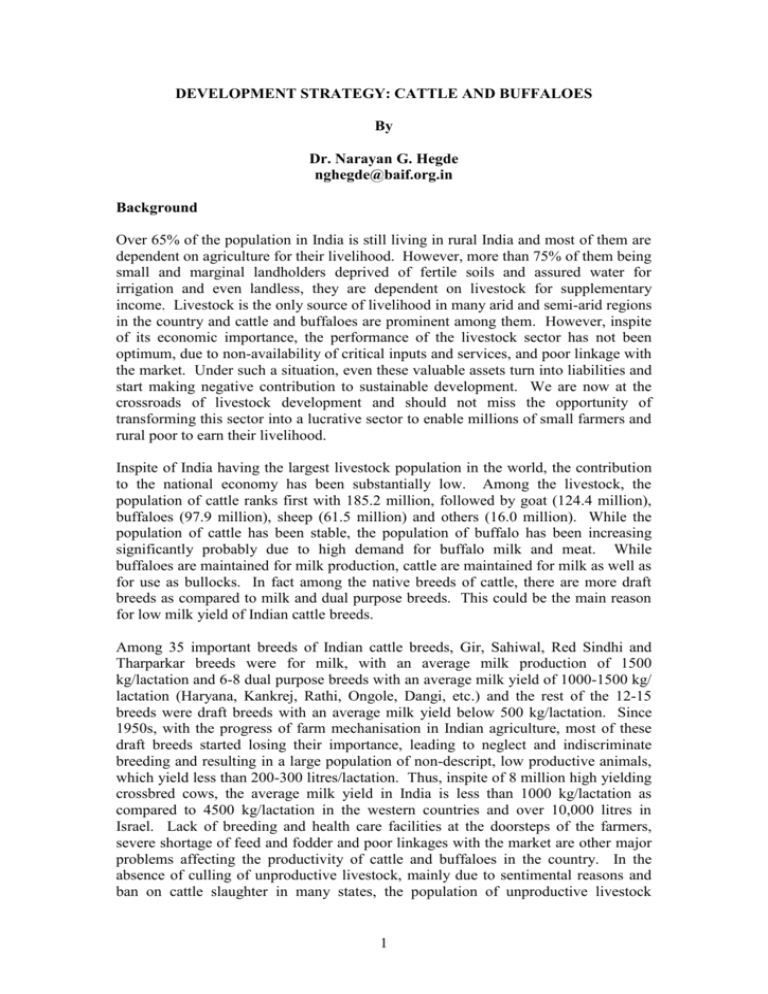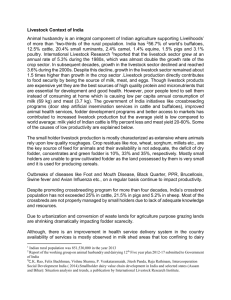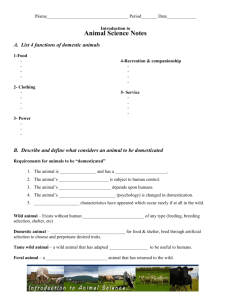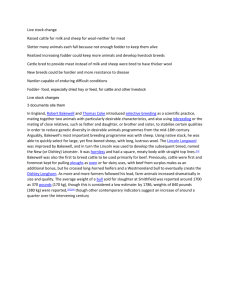Development Strategy for Cattle and Buffaloes
advertisement

DEVELOPMENT STRATEGY: CATTLE AND BUFFALOES By Dr. Narayan G. Hegde nghegde@baif.org.in Background Over 65% of the population in India is still living in rural India and most of them are dependent on agriculture for their livelihood. However, more than 75% of them being small and marginal landholders deprived of fertile soils and assured water for irrigation and even landless, they are dependent on livestock for supplementary income. Livestock is the only source of livelihood in many arid and semi-arid regions in the country and cattle and buffaloes are prominent among them. However, inspite of its economic importance, the performance of the livestock sector has not been optimum, due to non-availability of critical inputs and services, and poor linkage with the market. Under such a situation, even these valuable assets turn into liabilities and start making negative contribution to sustainable development. We are now at the crossroads of livestock development and should not miss the opportunity of transforming this sector into a lucrative sector to enable millions of small farmers and rural poor to earn their livelihood. Inspite of India having the largest livestock population in the world, the contribution to the national economy has been substantially low. Among the livestock, the population of cattle ranks first with 185.2 million, followed by goat (124.4 million), buffaloes (97.9 million), sheep (61.5 million) and others (16.0 million). While the population of cattle has been stable, the population of buffalo has been increasing significantly probably due to high demand for buffalo milk and meat. While buffaloes are maintained for milk production, cattle are maintained for milk as well as for use as bullocks. In fact among the native breeds of cattle, there are more draft breeds as compared to milk and dual purpose breeds. This could be the main reason for low milk yield of Indian cattle breeds. Among 35 important breeds of Indian cattle breeds, Gir, Sahiwal, Red Sindhi and Tharparkar breeds were for milk, with an average milk production of 1500 kg/lactation and 6-8 dual purpose breeds with an average milk yield of 1000-1500 kg/ lactation (Haryana, Kankrej, Rathi, Ongole, Dangi, etc.) and the rest of the 12-15 breeds were draft breeds with an average milk yield below 500 kg/lactation. Since 1950s, with the progress of farm mechanisation in Indian agriculture, most of these draft breeds started losing their importance, leading to neglect and indiscriminate breeding and resulting in a large population of non-descript, low productive animals, which yield less than 200-300 litres/lactation. Thus, inspite of 8 million high yielding crossbred cows, the average milk yield in India is less than 1000 kg/lactation as compared to 4500 kg/lactation in the western countries and over 10,000 litres in Israel. Lack of breeding and health care facilities at the doorsteps of the farmers, severe shortage of feed and fodder and poor linkages with the market are other major problems affecting the productivity of cattle and buffaloes in the country. In the absence of culling of unproductive livestock, mainly due to sentimental reasons and ban on cattle slaughter in many states, the population of unproductive livestock 1 continues to grow, exerting pressure on fodder, feed and forest resources, while contributing significantly to global warming and climate change. Inefficient use of dung which can be utilised for production of biogas before converting into farmyard manure is another cause of global warming, apart from the loss of opportunity to meet the energy needs. There is good scope to restrict the population growth while increasing the production of milk and other products through breed improvement, balanced feeding, timely action on preventive and curative health care and post production support for enriching the value chain. Hence, the development strategy should address all these problems faced by the farmers in improving the productivity and facilitate congenial conditions to earn sustainable livelihood without depleting the natural resources and the environment. Constraints in Management of Large Ruminants Major issues affecting the performance of large ruminants like cattle and buffaloes in the country are presented below: Over 65-70% female cattle are low productive, due to indiscriminate breeding and neglect, thereby turning dairy husbandry uneconomical. While the cows of most of the draft breeds are very low in milk production, the males have lost their utility as bullocks due to mechanisation in agriculture. In the absence of reliable data on the economics of non-descript and draft breeds and loss of opportunity, farmers have no interest in selection and maintenance of high value animals. Poor quality bulls used for semen collection and poor semen freezing facilities further affect the productivity of cattle and buffaloes. Poor access to breeding and veterinary care at the doorsteps of farmers is leading to genetic erosion and poor health status. Poor skills of paravets are resulting in infertility and other breeding problems. Lack of coordinated efforts for disease containment is causing major health problems. Increasing shortage of fodder and feed and poor emphasis on utilisation of crop residues are affecting the production. Due to non-availability of superior quality inputs at reasonable price, farmers are exploited by local traders. Lack of breeding policy and data on performance is leading to extinction of good native breeds and increasing exotic blood level, causing susceptibility to many diseases. 2 Inability to take up biogas production due to outdated technology, poor services and high cost. Lack of facilities for housing of unproductive and diseased animals pose burden on small farmers. Lack of awareness about clean milk production, poor market linkage, unfair trade practices and consumer-biased pricing for milk, which is nonremunerative for farmers. Inadequate facilities for fattening of buffaloes, particularly males and processing of buffalo meat, resulting in neglect of males and poor price realisation. Lack of awareness among small farmers about various opportunities for enhancing the production and increasing communication gap between male extension workers and female livestock owners, causing delay in adopting modern technologies. Goals for Development of Large Ruminant Sector As a result of the above unsolved problems, the dairy sector in particular is not able to achieve the expected annual growth of 10-12%. Therefore, we need to re-focus on the policies and programmes of dairy development to achieve the following goals: Conservation of elite native breeds; Breeding and selection of superior sires and setting up of high quality semen production laboratories to promote genetic improvement; Delivery of essential services at the doorsteps of farmers through well trained paravets, supported by veterinary doctors under public-private partnership; Coordinated efforts to take up preventive vaccination and health camps to stamp out major diseases; Efficient feed and fodder management by utilising community lands, wastelands and crop residues; Easy availability of superior quality inputs, without exploitation by traders. Facilities for housing culled and diseased animals in isolation. Clean milk production through awareness, timely health care and infrastructural support for efficient post handling of milk and other products; Strengthening of market value chain, eliminating exploitative middlemen, ensuring fair deal for farmers. Development of efficient farm implements to be operated by bullocks; Development of farmer-friendly policies to promote growth and enhance profits; 3 Proposed Strategy for Development of Cattle and Buffaloes To accelerate the growth and to achieve the above goals, it is necessary to promote the following activities: Genetic Improvement: The focus on genetic improvement of large ruminants should be to enhance milk production, while conserving native breeds, including the draft breeds of cattle. The proposed activities can be grouped into research, technology development and field services. The research activities proposed to be undertaken by the public research institutions and agricultural and animal science universities are: – Genomic studies to identify the genes/DNA sequences for various economic traits and resistance to stress and diseases and Genetic engineering to incorporate them for improvement of new progeny; – Production of sexed semen and sexed embryos and creation of gene banks of exotic and indigenous breeds; – Identification of elite cows and buffaloes in the field for herd registration; – Field data recording and establishment of national data bank for evaluation of sires under progeny testing and studying the performance and economics of various indigenous breeds and different blood levels of exotic breeds, should be the base for formulating the national breeding policy; – Standardisation of oestrous synchronisation technique to enhance the coverage of large ruminants under artificial insemination programme; Technological developments required to promote genetic improvement are: – Well coordinated programme for sire production, screening for genetically transmitted diseases, selection and evaluation of sires through progeny testing; – Registration of all the bulls selected for semen freezing and setting minimum standards for semen production; – Setting up high quality semen freezing facilities in public sector as well as under public private partnership, to ensure high quality and healthy competition; Field services required for promoting genetic improvement of cattle and buffaloes owned by farmers are establishment of livestock breeding facilities to provide breeding services along with minor veterinary health care at the doorsteps of farmers even in remote villages. Presently, breeding services are provided by the Animal Husbandry Departments, Cooperative, Dairy Federations, private and Government sponsored paravets and a 4 few non-profit organisations. Among them, the performance of non-profit organisations is far more superior because of the cost, quality, efficiency and reliability. With an initial development support for 4-6 years, these agencies can establish their services and continue to provide breeding services without any further financial burden on the Government. In comparison to their services, the services provided by the AHD will need huge financial and human resources, which are becoming scarce. The services of these non-profit agencies can also cover distribution of critical inputs such as fodder seeds, feeds, mineral mixture, dewormer, etc. apart from carrying out vaccination and minor veterinary services. The paravets working independently or with the support from AHD have not been providing reliable services, mainly due to poor technical skills, poor quality semen used, unassured supply of inputs and lack of supervision. This scheme needs to be strengthened by placing them directly under Dairy Federations or NGOs for quality control and regulation of the service fees charged to farmers. The paravets and the development agencies engaged in providing breeding services may also be entrusted with the responsibility of identifying elite animals which can be registered and used for production of bull mothers and breeding bulls required for future breed improvement. Livestock Health: Providing timely preventive and curative health care can play a significant role in promoting economic and clean milk production. Therefore, the following activities need to be promoted to improve the production of large ruminants: – Regular vaccinations, creation of disease-free zones and stamping out of major diseases; – Facilities for production of vaccines and diagnostics under Public-Private Partnership; – Establishment of Disease Investigation Labs at the district level and linking them with livestock breeding centres to provide diagnostic and advisory services through Block Veterinary Officers; – Establishment of disease investigation units at major livestock market yards to screen animals before selling and purchasing to prevent the spread of diseases and farmers from being cheated; – Organising periodic livestock health camps for handling problems of infertility, mastitis and other health related issues; – Promotion private veterinary services under the supervision of the AHD or Dairy Federation; Animal Nutrition: Balanced feeding is essential not only to enhance the milk production but also to economise the operation and to maintain good health of the animals. As there is a severe shortage of animal feeds and fodder in the country, serious efforts are needed to develop feed and fodder resources while expanding the dairy industry. 5 Some of the major initiatives needed to be promoted are presented below: – Development of high yielding forage varieties and popularisation of food crops / varieties having high straw yield; – Facilities for production and distribution of good quality seeds of outstanding varieties by establishing networking between Agricultural Universities, National Seed Corporation and farmers; – Establishment of fodder banks to collect and store surplus crop residues in fodder surplus areas, under public-private partnership for distributing to fodder scarcity areas; – Promotion of fodder production on degraded and wastelands and community pasture lands and under different farming systems; – Promotion of post-harvest technologies for storage of fodder and improving nutritive value of roughages; – Popularisation of complete feed, feed with by-pass protein, microbial protein, azola, spirulina and non-traditional feed ingredients; – Decentralised production of complete feed through community initiatives, using locally available biomass; Value Addition and Market Linkage: The success of the livestock development programme is dependent on value addition and better price realisation of the produce. Milk being a perishable commodity, facilities for timely collection nearer their house and payment of remunerative price are essential to encourage the dairy farmers. Preventing wastage of milk due to contamination, unfair trade practices and elimination of unnecessary intermediate agencies in marketing can further enhance the profit margins. Presently only 30% of the milk is sold through the organised sector. The major players in this sector are Cooperative Dairy Federations and a few private agencies engaged in selling of fresh milk and milk products and confectionaries. There are a large number of sweet makers in most of the urban and semi-urban areas who are engaged in procurement of raw milk either directly or through middlemen. However, most of the farmers selling milk through the unorganised sector are unable to get a better deal, either due to compulsion or ignorance. Unfortunately, they have no other option, particularly in areas where Dairy Cooperatives are defunct or operating without efficiency and transparency. It is therefore necessary to address these problems and strengthen the network of milk collection centres and their direct linkage with the milk processing units. Some of the recommendations in this area are: - Installation of automated bulk milk coolers, which can assess the quality of milk and fix the price and total value of the milk on the spot 6 - Awareness about clean milk production and methods to keep the bacterial count low from the period of milking till delivery to bulk milk coolers - Decentralised mini-dairies which can ensure transparency and efficiency, while generating local employment and reducing the cost of processing and marketing of milk and milk products - Development of new, healthy dairy products to attract new consumers - Consumer awareness about milk quality Other Support Activities A few more initiatives are needed to strengthen the development of the large ruminant sector. These are presented below: 1. Development and popularisation of efficient bullock-drawn implements and machines, particularly implements which can be drawn by a single bullock 2. Identification of opportunities for using bullocks as an alternative source of energy 3. Policy for regular culling of unwanted and sick animals and facilities for housing them in quarantine 4. Facilities for fattening of buffaloes 5. Establishment of modern meat processing units and linking them with farmers rearing buffaloes for meat 6. Development of efficient designs for compact biogas plants 7. Research and development for reduction in methane emission by livestock, particularly through modified feeding and housing Many of these aspects can be addressed through suitable policies. Various recommendations can be incorporated in the on-going schemes to boost dairy husbandry in the country. 7






